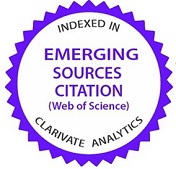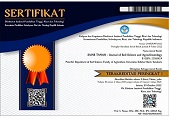Estimation of water use efficiency (WUE) for efficient irrigation level of oil palm during the main nursery phase
Abstract
Keywords
Full Text:
PDFReferences
Afandi, A. M., Zulkifli, H., Nur Zuhaili, H. A. Z. A., Norliyana, Z. Z., Hisham, H., Saharul, A. M., . . . Vu Thanh, T. A. (2023). Oil palm water requirement and the need for irrigation in dry Malaysian areas. Journal of Oil Palm Research, 35(3), 391-405. https://doi.org/10.21894/jopr.2022.0052
Agele, S., Charles, F. E., Obi, A. E., & Agbona, A. I. (2022). Oil Palm-Based Cropping Systems of the Humid Tropics: Addressing Production Sustainability, Resource Efficiency, Food Security and Livelihood Challenges. In H. Kamyab (Ed.), Elaeis guineensis. IntechOpen. https://doi.org/10.5772/intechopen.98257
Ahmed, A., Mohd, Y. B. I., & Abdullah, A. M. (2021). Oil palm in the face of climate change: A review of recommendations. IOP Conference Series: Earth and Environmental Science, 646(1), 012065. https://doi.org/10.1088/1755-1315/646/1/012065
Aholoukpè, H., Dubos, B., Flori, A., Deleporte, P., Amadji, G., Chotte, J. L., & Blavet, D. (2013). Estimating aboveground biomass of oil palm: Allometric equations for estimating frond biomass. Forest Ecology and Management, 292, 122-129. https://doi.org/10.1016/j.foreco.2012.11.027
Bayona-Rodriguez, C. J., & Romero, H. M. (2019). Physiological and agronomic behavior of commercial cultivars of oil palm ('Elaeis guineensis') and OxG hybrids ('Elaeis oleifera'x'Elaeis guineensis') at rainy and dry seasons. Australian Journal of Crop Science, 13(3), 424-432. https://doi.org/10.21475/ajcs.19.13.03.p1354
Brum, M., Oliveira, R. S., López, J. G., Licata, J., Pypker, T., Chia, G. S., . . . Asbjornsen, H. (2021). Effects of irrigation on oil palm transpiration during ENSO-induced drought in the Brazilian Eastern Amazon. Agricultural Water Management, 245, 106569. https://doi.org/10.1016/j.agwat.2020.106569
Carr, M. K. V. (2011). The water relations and irrigation requirements of oil palm (Elaeis guineensis): A review. Experimental Agriculture, 47(4), 629-652. https://doi.org/10.1017/S0014479711000494
Chalvantharan, A., Lim, C. H., & Ng, D. K. S. (2023). Economic Feasibility and Water Footprint Analysis for Smart Irrigation Systems in Palm Oil Industry. Sustainability, 15(10), 8069. https://doi.org/10.3390/su15108069
Choukri, M., Naimi, M., & Chikhaoui, M. (2023). Drought characterization: A systematic literature review. Sains Tanah Journal of Soil Science and Agroclimatology, 20(2), 15. https://doi.org/10.20961/stjssa.v20i2.77206
Christensen, J. H., Kanikicharla, K. K., Aldrian, E., An, S. I., Albuquerque Cavalcanti, I. F., de Castro, M., . . . Zou, L. (2013). Climate phenomena and their relevance for future regional climate change. In Climate Change 2013 – The Physical Science Basis (Vol. 9781107057999, pp. 1217-1308). Cambridge University Press. https://doi.org/10.1017/CBO9781107415324.028
Corley, R. H. V., & Tinker, P. B. (2015). The oil palm (5th ed.). John Wiley & Sons.
Darlan, N. H., Pradiko, I., & Siregar, H. H. (2016). Dampak el nino 2015 terhadap performa tanaman kelapa sawit di bagian selatan sumatera [Effect of El Nino 2015 on oil palm performance in Central and Southern Sumatera]. Jurnal tanah dan iklim, 40(2), 113-120. https://epublikasi.pertanian.go.id/berkala/jti/article/view/3183
Delgado, T., Ladino, G., & Arias, N. (2024). Evaluation of the Effect of Soil Water Conditions on the Development and Water Requirements of Adult Oil Palm (Elaeis guineensis Jacq.) in the Northern Region of Colombia. Agronomy, 14(9), 1976. https://doi.org/10.3390/agronomy14091976
Evizal, R., Sari, R. Y., Saputra, H., Setiawan, K., & Prasmatiwi, F. E. (2021). Pengaruh Irigasi pada Pertumbuhan dan Produksi Kelapa Sawit [The Effect of Irrigation on the Growth and Yield of Oil Palm]. Jurnal Agrotropika, 20(1), 58-67. https://doi.org/10.23960/ja.v20i1.4848
Franks, P. J., W. Doheny-Adams, T., Britton-Harper, Z. J., & Gray, J. E. (2015). Increasing water-use efficiency directly through genetic manipulation of stomatal density. New Phytologist, 207(1), 188-195. https://doi.org/10.1111/nph.13347
Harahap, I., & Darmosarkoro, W. (1999). Pendugaan kebutuhan air untuk pertumbuhan kelapa sawit di lapang dan aplikasinya dalam pengembangan sistem irigasi [Estimation of Water Requirements for Oil Palm Growth in the Field and Its Application in Irrigation System Development]. Jurnal Penelitian Kelapa Sawit, 7(2), 87-104. https://pis.iopri.co.id/upload/journalIOPRI/files/230822105956.pdf
Hatfield, J. L., & Dold, C. (2019). Water-Use Efficiency: Advances and Challenges in a Changing Climate [Review]. Frontiers in Plant Science, Volume 10 - 2019. https://doi.org/10.3389/fpls.2019.00103
Hebbar, K. B., Apshara, E., Chandran, K. P., & Prasad, P. V. V. (2020). Effect of elevated CO2, high temperature, and water deficit on growth, photosynthesis, and whole plant water use efficiency of cocoa (Theobroma cacao L.). International Journal of Biometeorology, 64(1), 47-57. https://doi.org/10.1007/s00484-019-01792-0
Ikhajiagbe, B., Aituae, W., & Ogwu, M. (2022). Morpho-physiological assessment of oil palm (Elaeis guineensis Jacq.) seedlings exposed to simulated drought conditions. Journal of Oil Palm Research (Malaysia), 34(1), 26-34. https://doi.org/10.21894/jopr.2021.0018
Mehdi Jazayeri, S., Rivera, Y. D., Camperos-Reyes, J. E., & Romero, H. M. (2015). Physiological effects of water deficit on two oil palm (Elaeis guineensis Jacq.) genotypes. Agronomía Colombiana, 33(2), 164-173. https://www.redalyc.org/articulo.oa?id=180341167006
Monzon, J. P., Jabloun, M., Cock, J., Caliman, J.-P., Couëdel, A., Donough, C. R., . . . Grassini, P. (2022). Influence of weather and endogenous cycles on spatiotemporal yield variation in oil palm. Agricultural and Forest Meteorology, 314, 108789. https://doi.org/10.1016/j.agrformet.2021.108789
Muhamad, H., Subramaniam, V., Hashim, Z., Khairuddin, N. S. K., & May, C. Y. (2014). Water footprint: Part 1-production of oil palm seedlings in Peninsular Malaysia. Journal of Oil Palm Research, 26(4), 273-281. https://jopr.mpob.gov.my/water-footprint-part-1-production-of-oil-palm-seedlings-in-peninsular-malaysia/
Murphy, D. J., Goggin, K., & Paterson, R. R. M. (2021). Oil palm in the 2020s and beyond: challenges and solutions. CABI Agriculture and Bioscience, 2(1), 39. https://doi.org/10.1186/s43170-021-00058-3
Najihah, T. S., Ibrahim, M. H., Razak, A. F. A., Nulit, R., & Wahab, P. E. M. (2019). Effects of water stress on the growth, physiology and biochemical properties of oil palm seedlings. AIMS Agriculture and Food, 4(4), 854-868. https://doi.org/10.3934/agrfood.2019.4.854
Noor, M. R. M., & Harun, M. H. (2007). Technique for determining Water Use Efficiency (WUE) in oil palm. MPOB Information Series. http://tot.mpob.gov.my/tt-no-354-technique-for-determining-water-use-efficiency-wue-in-oil-palm/
Pangaribuan, I. F., & Akoeb, E. N. (2022). Analysis of morphological responses of drought stress oil palm in nursery phase. IOP Conference Series: Earth and Environmental Science, 977(1), 012013. https://doi.org/10.1088/1755-1315/977/1/012013
Pangaribuan, I. F., Rahmawati, N., Akoeb, E. N., Yenni, Y., Sujadi, & Pangaribuan, Y. (2024). Reactions of Drought-Affected Oil Palm Variety Seedlings during the Nursery Phase: Bud and Root Responses. IOP Conference Series: Earth and Environmental Science, 1308(1), 012034. https://doi.org/10.1088/1755-1315/1308/1/012034
Pradiko, I., Ginting, E. N., Darlan, N. H., Winarna, & Siregar, H. H. (2016). Hubungan pola curah hujan dan performa tanaman kelapa sawit di Pulau Sumatra dan Kalimantan selama El Nino 2015 [The Relationship Between Rainfall Patterns and Oil Palm Performance in Sumatra and Kalimantan During the 2015 El Niño]. Jurnal Penelitian Kelapa Sawit, 24(2), 87-96. https://core.ac.uk/reader/231264600
Pradiko, I., Rahutomo, S., Farrasati, R., Ginting, E. N., Hidayat, F., & Syarovy, M. (2022). Transpiration of oil palm (Elaeis guineensis Jacq.) based on sap flow measurement: the relation to soil and climate variables. Journal of Oil Palm Research, 35(1), 168-184. https://doi.org/10.21894/jopr.2022.0035
Rivera-Mendes, Y. D., Cuenca, J. C., & Romero, H. M. (2016). Physiological responses of oil palm (Elaeis guineensis Jacq.) seedlings under different water soil conditions. Agronomía Colombiana, 34(2), 163-171.
Sianipar, E. M. (2021). Pengaruh Perubahan Iklim Terhadap Ekofisiologi Tanaman Kelapa Sawit (Elaeis guineensis Jacq.) [The Impact of Climate Change on the Ecophysiology of Oil Palm (Elaeis guineensis Jacq.)]. Majalah Ilmiah Methoda, 11(1), 75-80. https://doi.org/10.46880/methoda.Vol11No1.pp75-80
Sigalingging, R., Sumono, & Rahmansyah, N. (2018). Evapotranspiration and crop coefficient of oil palm (Elaeis guineensis Jacq.) on the main nursery in a greenhouse. IOP Conference Series: Earth and Environmental Science, 122(1), 012099. https://doi.org/10.1088/1755-1315/122/1/012099
Silalahi, J. E. L., & Charloq, F. (2021). The Effect of Watering Frequency on Several Types of Oil Palm (Elais guineensis Jacq.) Great Bunches Superior Seeds ‘Yangambi’in Main Nursery Ages of 4 to 7 Months. JURNAL AGROTEKNOLOGI, 9(1). https://talenta.usu.ac.id/joa/article/view/6530
Sujadi, S., Pradiko, I., Rahutomo, S., & Farrasati, R. (2020). Prediksi Kemampuan Adaptasi Delapan Varietas Kelapa Sawit pada Cekaman Abiotik Akibat Perubahan Iklim Global [Prediction of the Adaptive Capacity of Eight Oil Palm Varieties Under Abiotic Stress Caused by Global Climate Change]. Jurnal tanah dan iklim, 44(2), 129-139. https://epublikasi.pertanian.go.id/berkala/jti/article/view/3262
Sukmawan, Y., & Riniarti, D. (2020). Respons Pertumbuhan Bibit Kelapa Sawit Akibat Pengaturan Bobot Mulsa Tandan Kosong dan Frekuensi Penyiraman [Growth Response of Oil Palm Seedlings to Empty Fruit Bunch Mulching and Watering Frequency Adjustment]. Jurnal Penelitian Kelapa Sawit, 28(3), 159-168. https://doi.org/10.22302/iopri.jur.jpks.v28i3.121
Sukmawan, Y., Riniarti, D., & Pranandi, G. (2022). The Effect of Irrigation Time and Slow-Release Fertilizer on Oil Palm Seedlings Under Controlled Drip Irrigation System. IOP Conference Series: Earth and Environmental Science, 1012(1), 012025. https://doi.org/10.1088/1755-1315/1012/1/012025
Sukmawan, Y., Riniarti, D., Utoyo, B., & Rifai, A. (2019). Efisiensi air pada pembibitan utama kelapa sawit melalui aplikasi mulsa organik dan pengaturan volume penyiraman [Water Use Efficiency in Main Nursery of Oil Palm Through Organic Mulch Application and Irrigation Volume Management]. Jurnal Pertanian Presisi (Journal of Precision Agriculture), 3(2), 141-154. https://doi.org/10.35760/jpp.2019.v3i2.2331
Tran, N., Bam, P., Black, K., Graham, T., Ping, Z., Dixon, M., . . . Downey, A. (2015). Improving irrigation scheduling protocols for nursery trees by relating cumulative water potential to concurrent vapour pressure deficitâ©. https://doi.org/10.17660/ActaHortic.2015.1085.22
Trinugroho, M. W., Arif, S. S., Susanto, S., & Nugroho, B. D. A. (2024). Assessing irrigation water demand and pumping operations for rice farming in the Bengawan Solo River, Indonesia. Sains Tanah Journal of Soil Science and Agroclimatology, 21(1), 13. https://doi.org/10.20961/stjssa.v21i1.79343
Refbacks
- There are currently no refbacks.











.png)





